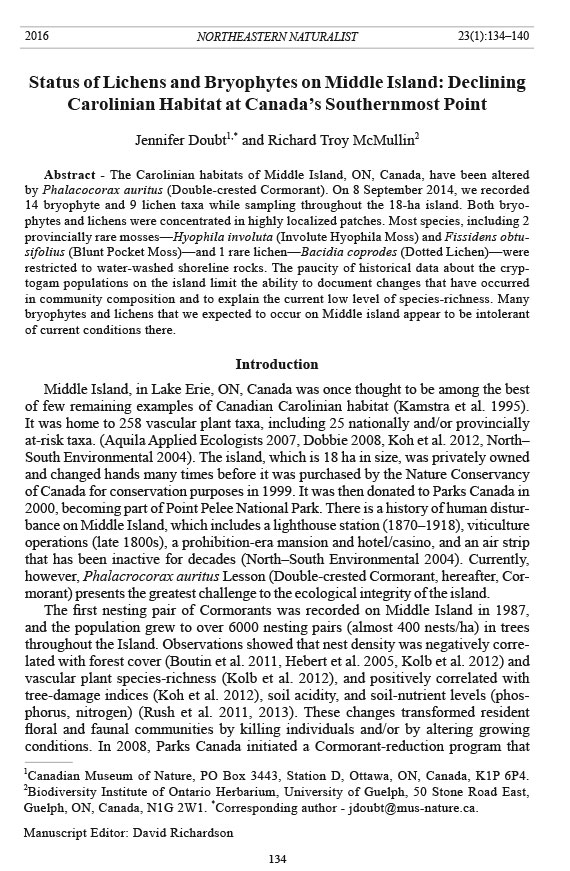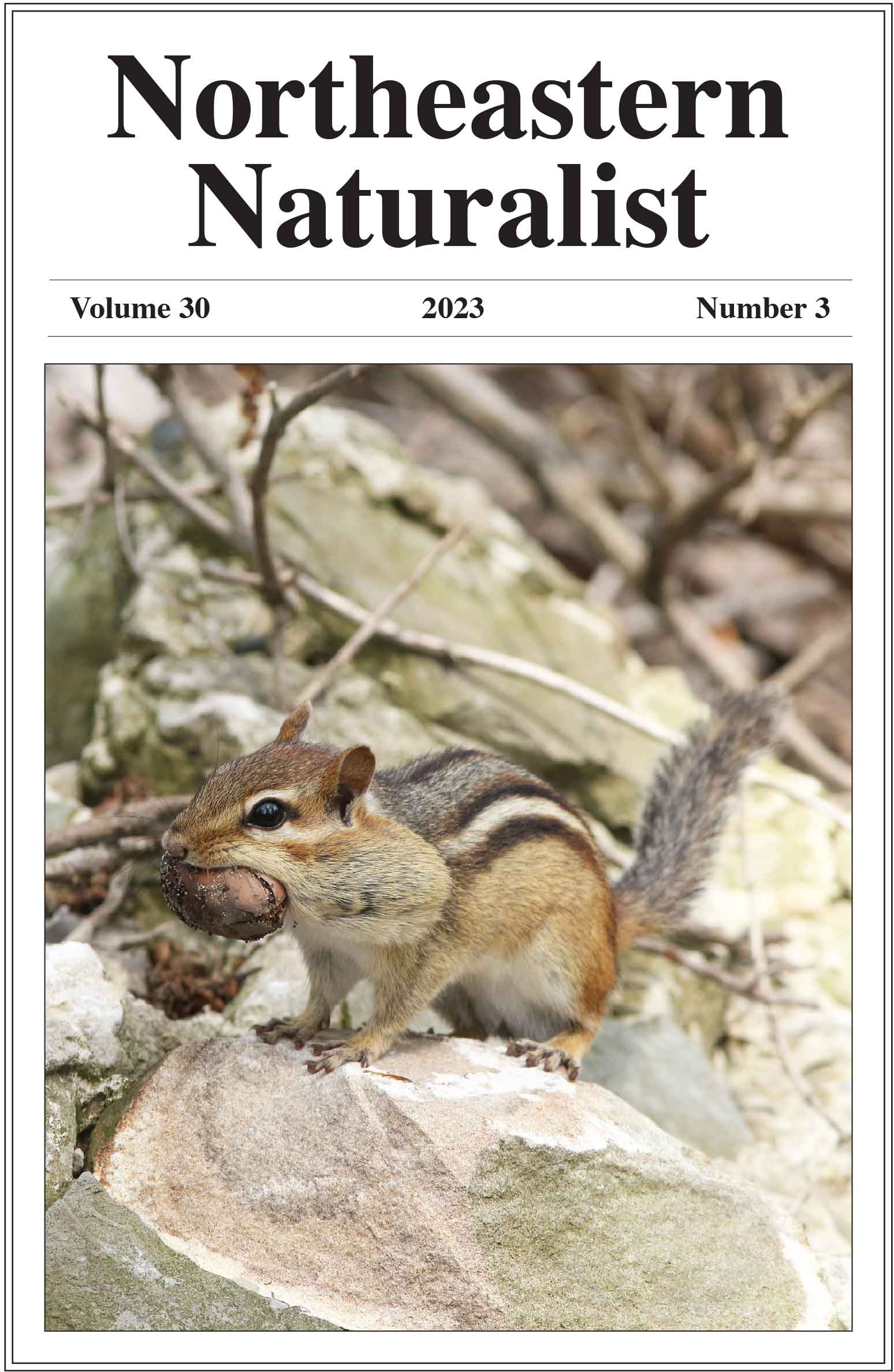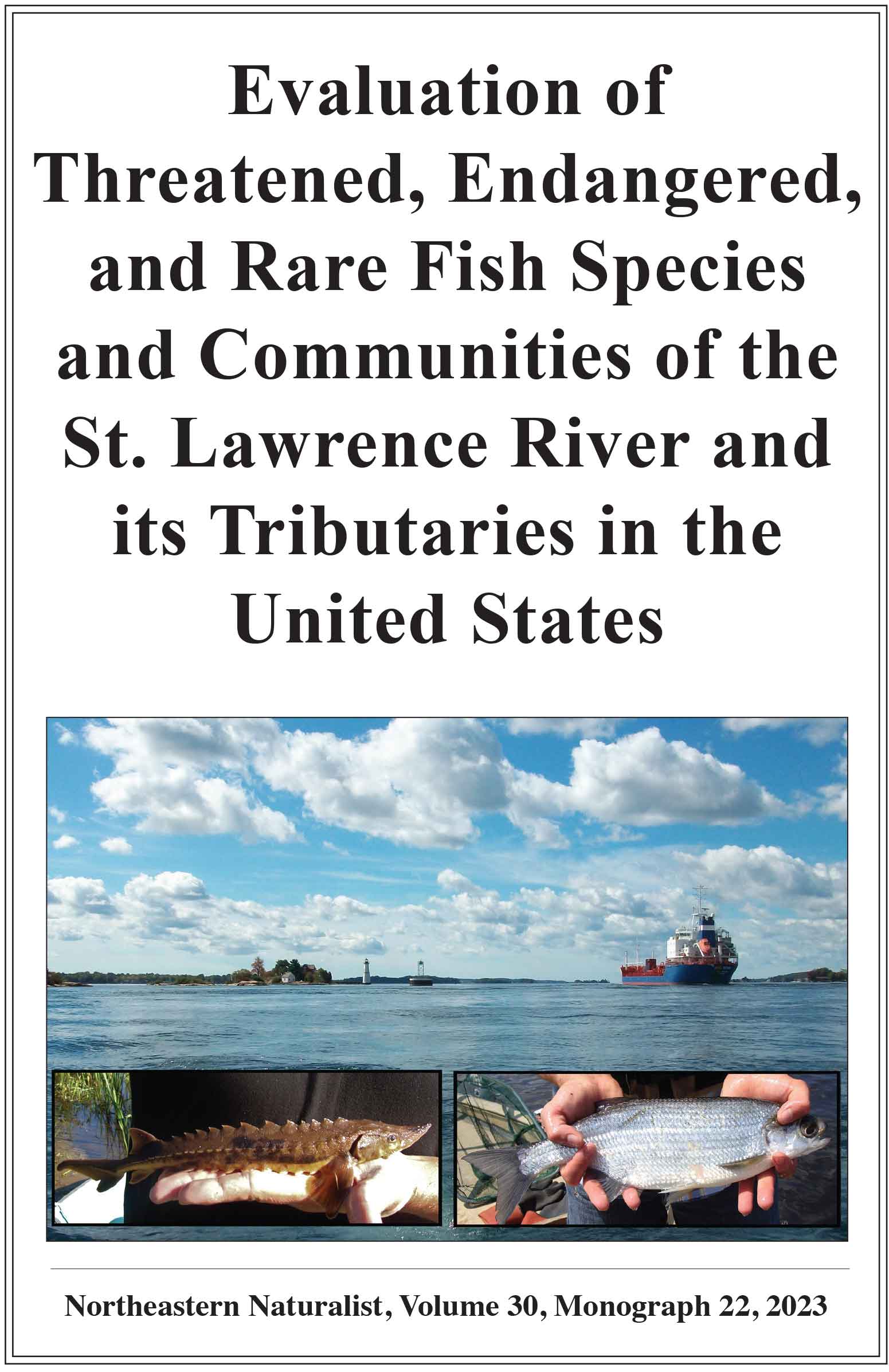Status of Lichens and Bryophytes on Middle Island: Declining
Carolinian Habitat at Canada’s Southernmost Point
Jennifer Doubt and Richard Troy McMullin
Northeastern Naturalist, Volume 23, Issue 1 (2016): 134–140
Full-text pdf (Accessible only to subscribers. To subscribe click here.)

Access Journal Content
Open access browsing of table of contents and abstract pages. Full text pdfs available for download for subscribers.
Current Issue: Vol. 30 (3)

Check out NENA's latest Monograph:
Monograph 22









Northeastern Naturalist
134
J. Doubt and R.T. McMullin
22001166 NORTHEASTERN NATURALIST 2V3(o1l). :2133,4 N–1o4. 01
Status of Lichens and Bryophytes on Middle Island: Declining
Carolinian Habitat at Canada’s Southernmost Point
Jennifer Doubt1,* and Richard Troy McMullin2
Abstract - The Carolinian habitats of Middle Island, ON, Canada, have been altered
by Phalacocorax auritus (Double-crested Cormorant). On 8 September 2014, we recorded
14 bryophyte and 9 lichen taxa while sampling throughout the 18-ha island. Both bryophytes
and lichens were concentrated in highly localized patches. Most species, including 2
provincially rare mosses—Hyophila involuta (Involute Hyophila Moss) and Fissidens obtusifolius
(Blunt Pocket Moss)—and 1 rare lichen—Bacidia coprodes (Dotted Lichen)—were
restricted to water-washed shoreline rocks. The paucity of historical data about the cryptogam
populations on the island limit the ability to document changes that have occurred
in community composition and to explain the current low level of species-richness. Many
bryophytes and lichens that we expected to occur on Middle island appear to be intolerant
of current conditions there.
Introduction
Middle Island, in Lake Erie, ON, Canada was once thought to be among the best
of few remaining examples of Canadian Carolinian habitat (Kamstra et al. 1995).
It was home to 258 vascular plant taxa, including 25 nationally and/or provincially
at-risk taxa. (Aquila Applied Ecologists 2007, Dobbie 2008, Koh et al. 2012, North–
South Environmental 2004). The island, which is 18 ha in size, was privately owned
and changed hands many times before it was purchased by the Nature Conservancy
of Canada for conservation purposes in 1999. It was then donated to Parks Canada in
2000, becoming part of Point Pelee National Park. There is a history of human disturbance
on Middle Island, which includes a lighthouse station (1870–1918), viticulture
operations (late 1800s), a prohibition-era mansion and hotel/casino, and an air strip
that has been inactive for decades (North–South Environmental 2004). Currently,
however, Phalacrocorax auritus Lesson (Double-crested Cormorant, hereafter, Cormorant)
presents the greatest challenge to the ecological integrity of the island.
The first nesting pair of Cormorants was recorded on Middle Island in 1987,
and the population grew to over 6000 nesting pairs (almost 400 nests/ha) in trees
throughout the Island. Observations showed that nest density was negatively correlated
with forest cover (Boutin et al. 2011, Hebert et al. 2005, Kolb et al. 2012) and
vascular plant species-richness (Kolb et al. 2012), and positively correlated with
tree-damage indices (Koh et al. 2012), soil acidity, and soil-nutrient levels (phosphorus,
nitrogen) (Rush et al. 2011, 2013). These changes transformed resident
floral and faunal communities by killing individuals and/or by altering growing
conditions. In 2008, Parks Canada initiated a Cormorant-reduction program that
1Canadian Museum of Nature, PO Box 3443, Station D, Ottawa, ON, Canada, K1P 6P4.
2Biodiversity Institute of Ontario Herbarium, University of Guelph, 50 Stone Road East,
Guelph, ON, Canada, N1G 2W1. *Corresponding author - jdoubt@mus-nature.ca.
Manuscript Editor: David Richardson
Northeastern Naturalist Vol. 23, No. 1
J. Doubt and R.T. McMullin
2016
135
decreased nest density to ~200 nests/ha (Hebert et al. 2014), but the current population
continues to impair restoration potential on the island (Boutin et al. 2011; Koh
et al. 2012; Rush et al. 2011, 2013). Diversity and abundance of vascular plants on
Middle Island, including rare species, have declined, presumably due to the effects
of Cormorant presence (Aquila Applied Ecologists 2007, Boutin et al. 2011, Hebert
et al. 2005, North–South Environmental 2004).
Despite the botanical-survey work on Middle Island since 1948 (North–South
Environmental 2004), bryophytes and lichens have received little attention. Herbarium
records from the National Herbarium of Canada (CANM and CANL, for
mosses and lichens, respectively, Canadian Museum of Nature, Gatineau, QC,
Canada), the University of Guelph Herbarium (OAC; Guelph, ON, Canada), and the
Green Plant Herbarium (TRT; the Royal Ontario Museum, Toronto, ON, Canada),
and all records compiled on-line by the Consortia of North American Bryophyte and
Lichen Herbaria suggest that in total, 0 lichens and just 9 bryophyte species were
documented by 2 separate collectors (M.J. Oldham, Ontario Ministry of Natural
Resources and Forestry, Peterborough, ON, Canada and S.J. Darbyshire, Agriculture
and Agrifood Canada, Ottawa, ON, Canada) prior to our visit in 2014. Both
collectors confirm (through pers. comm. to J. Doubt) that bryophyte collecting was
incidental to their main purpose for visiting the island; thus, no comprehensive surveys
have been documented.
Site Description and Methods
On 8 September 2014, we made a 6-h visit to Middle Island, an 18-ha island
~4 km south of Pelee Island in Lake Erie (Fig. 1). We circumnavigated the island
on foot and traversed it at 5 roughly equalt intervals through its interior forest.
Figure 1. Location of Middle Island, ON, Canada, in the context of western Lake Erie.
Northeastern Naturalist
136
J. Doubt and R.T. McMullin
2016 Vol. 23, No. 1
Throughout the survey, we visited all mesohabitat types represented on the island,
and examined as many examples as possible of all microhabitat types present
within each mesohabitat (Newmaster et al. 2005).
We used microscopy and current taxonomic resources (Faubert 2012, 2013,
2014; Flora of North America Editorial Committee 2007, 2014) to identify bryophytes,
and microscopy and chemical spot tests following Brodo et al. (2001) to
identify lichens. We further examined lichen specimens that could not reliably be
identified by these means by using thin-layer chromatography (solvents A and C)
following Culberson and Kristinsson (1970) and Orange et al. (2001). We deposited
vouchers at CANM (bryophytes) and OAC (lichens).
Results
We recorded 14 bryophyte (13 moss, 1 liverwort) and 9 lichen taxa (Table 1).
Most of these taxa are common and widespread in Ontario; however, 2 mosses, Hyophila
involuta (Involute Hyophila Moss) and Fissidens obtusifolius (Blunt Pocket
Table 1. Bryophytes and lichens documented on Middle Island during a 1-d survey in September 2014,
including their provincial sub-national conservation ranks, or SRanks, and the habitats (F = forest, S
= shore) and substrates (L = lignicolous, C = corticolous, S = saxicolous) with which they were associated.
Saxicolous species were on calcareous rock; corticolous lichens were on Celtis occidentalis
(Hackberry). There was insufficient material to allow for identification of 2 bryophytes beyond the
genus level. * indicates the most commonly-encountered taxa in each group.
Sub-
Species SRank Habitat strate
Bryophytes
*Hygroamblystegium varium (Hedw.) Mönk. S5 F,S L,S
Brachythecium rutabulum (Hedw.) Schimp. in B.S.G S5 F L
Bryum s.l. F L
Ceratodon purpureus (Hedw.) Brid. S5 F L
Entodon seductrix (Hedw.) Müll. Hal. S4 F L
Fissidens obtusifolius Wils. S2 S S
Funaria hygrometrica Hedw. S5 S S
Gymnostomum aeruginosum Sm. S5 S S
Haplocladium microphyllum (Hedw.) Broth. S4 F L
Hyophila involuta (Hook.) Jaeg. S3 S S
Leptobryum pyriforme (Hedw.) Wils. S5 S S
Marchantia polymorpha L. S5 S S
*Plagiomnium cuspidatum (Hedw.) T. J. Kop. S5 F,S L,S
Tortula S S
Lichens
Amandinea punctata (Hoffm.) Coppins & Scheid. S5 S L
Bacidia coprodes (Körb.) Lettau S1S2 S S
Candelaria concolor (Dicks.) Stein S5 S C
Hyperphyscia adglutinata (Flörke) H. Mayrhofer & Poelt S4 S C
*Lecanora dispersa (Pers.) Sommerf. S5 S S
Phaeophyscia adiastola (Essl.) Essl. S4 S C
Physcia stellaris (L.) Nyl. S5 S C
*Xanthocarpia feracissima (H. Magn.) Frödén, Arup & Søchting S5 S S
Xanthomendoza ulophyllodes (Räsänen) Søchting, Kärnefelt & S.Y. Kondr. SNR S C
Northeastern Naturalist Vol. 23, No. 1
J. Doubt and R.T. McMullin
2016
137
Moss), and the lichen Bacidia coprodes (Dotted Lichen) are rare and tracked by the
Ontario Natural Heritage Information Centre (2014).
Lichens and bryophytes tended to occur in localized patches. Most surfaces
were uncolonized, and even the most common species occupied a small fraction
of the substrates that would normally support them. We found the greatest abundance
of bryophytes along the water-washed rock surfaces of the island’s northeast
shoreline; the rest of the shoreline habitat was largely devoid of bryophytes. In the
forested interior of the island and on the ruins of former stone buildings, healthy
bryophyte colonies were extremely rare, and we only observed them on a few decaying
logs within a small patch of dense understory scrub in the northwest.
Lichens were absent from the forest interior, and were restricted to shoreline rocks
and forests. We discovered the most common saxicolous lichen species throughout
the coastal limestone shelf on the north, east, and south sides of the island, whereas
corticolous species were limited to a small forested area on the island’s south side.
This area appeared to be less affected by Cormorants than elsewhere on the island.
We found 2 lichen species—Amandinea punctata (Tiny Button Lichen) and Dotted
Lichen—just once, on the northeast side of the island.
Discussion
The bryophyte and lichen floras of Middle Island are the most species-poor
among the Canadian natural areas we have examined. While additional species
may occur in inconspicuous and less accessible microhabitats, the striking absence
of bryophytes and lichens from their typical substrates confirms that their current
diversity and abundance are extremely low. These organisms are known to be sensitive
to changes in environmental chemistry, moisture, and light (e.g., McMullin
2010, 2013; Vanderpoorten and Goffinet 2009). The forest-canopy reduction from
90% to 46% as a result of tree mortality due to the Cormorants (Hebert et al. 2014)
has likely caused substantial changes to the moisture and light regimes in all the
forest microhabitats. The levels of nutrients and changes in pH, even in areas with
a low density of nests where nutrients may be insufficient to be directly toxic, may
have shifted growing conditions beyond the tolerance ranges of most forest lichen
and bryophyte species. The prospects for forest-habitat recovery are uncertain
(Herbert et al. 2014, Koh et al. 2012, Rush et al. 2013), and for sensitive species
(such as bryophytes and lichens) it may be particularly slow. In Poland, Żółkoś et al.
(2013) observed some recolonization by epiphytic forest-lichen species after nest
sites were abandoned by Ardea cinerea L. (Grey Herons), but found that community
composition was altered in the long term.
One might expect that on Middle Island’s rocky shorelines, contact with lake water
(i.e., waves or spray), prevalence of less-permeable substrates, and distance from
overhead-nest trees may offer refuge to the subset of resident species—largely bryophytes—
adapted to this habitat type. The persistence, in this microhabitat type, of the
only 3 rare species detected during our survey, suggests that it may well be the case.
Three bryophyte species documented by this study—Hygroamblystegium
varium, (Tangled Thread Moss), Funaria hygrometrica (Bonfire Moss), and
Northeastern Naturalist
138
J. Doubt and R.T. McMullin
2016 Vol. 23, No. 1
Plagiomnium cuspidatum (Baby Tooth Moss)—were known from the island prior
to the dramatic increase in Cormorant numbers. Species that were collected in
the early 1980s but not seen in 2014 were Anomodon rostratus (Hedw.) Schimp.
(Yellow Yarn Moss), Bryhnia graminicolor (Brid.) Grout (Grass-colored Moss),
Ptychostomum creberrimum (Taylor) J.R. Spence & H.P. Ramsay (Scarlet Stalk
Moss), Taxiphyllum deplanatum (Bruch & Schimp. ex Sull.) M. Fleisch (Sprouting
Silk Moss), and the nationally rare Tortula porteri (James) Brotherus in H.G.A.
Engler and K. Prantl (Porter’s Twisted Moss). The potential loss of Porter’s Twisted
Moss, which in Canada is only known from small limestone areas in the warmest
parts of Ontario (Niagara Peninsula, Pelee and Middle Islands), is particularly
significant because its populations on nearby Pelee Island are small and suitable
habitat there is rare (COSEWIC, in prep). Several other US and Canadian islands
in the Lake Erie archipelago, where this moss has been recorded or is expected to
have occurred, are currently also affected by Cormorants (Hebert et al. 2014, Sherman
2007).
We can only speculate on the composition and diversity of the former bryophyte
and lichen community on Middle Island. Bryophyte surveys in 1945 of 2
limestone-dominated islands in the US portion of the same western Lake Erie
archipelago—Green Island (7 ha and ~15 km southwest of Middle Island) and
Rattlesnake Island (34 ha and ~13 km west of Middle Island)—yielded 64 species
following a 6-h search and 48 species after 4 h, respectively (Schnooberger
and Wynne-Hillier 1954). The habitats on Green Island at that time seem to match
those on Middle Island, which, prior to Cormorant colonization, included forests
dominated by Celtis occidentalis L. (Hackberry), Acer nigrum F. Michx. (Black
Maple), Ptelea trifoliata L. (Hop-tree), Fraxinus quadrangulata Michx. (Blue
Ash), and/or Quercus muehlenbergii Engelm. (Chinquapin Oak) as well as scrub,
pond, and rocky shoreline communities (North–South Environmental 2004).
Nearby Pelee Island currently retains remnants of natural forest habitat; thus,
studies there may be somewhat useful in hypothesizing the probable original
cryptogam biota of Middle Island.
We hope that the results of our brief survey will serve as a useful snapshot to
inform future research and habitat management on Middle Island.
Acknowledgments
We are grateful to staff at Point Pelee Provincial Park, particularly Tammy Dobbie, for
access, information, and logistical support.
Literature Cited
Aquila Applied Ecologists. 2007. Impacts of Double-crested Cormorants (Phalacrocorax
auritus) populations on the biodiversity of islands in western Lake Erie: Management
recommendations, update January 2007. Unpublished report to Point Pelee National
Park of Canada, Leamington, ON, Canada. 71 pp.
Boutin, C., T. Dobbie, D. Carpenter, and C.E. Hebert. 2011. Effects of Double-crested
Cormorants (Phalacrocorax auritus) on island vegetation, seedbank, and soil chemistry:
Evaluating island restoration potential. Restoration Ecology 19:720–727.
Northeastern Naturalist Vol. 23, No. 1
J. Doubt and R.T. McMullin
2016
139
Brodo, I.M., S.D. Sharnoff, and S. Sharnoff. 2001. Lichens of North America. Yale University
Press, New Haven, CT. 795 pp.
Committee on the Status of Endangered Wildlife in Canada (COSEWIC). In prep. COSEWIC
Status Report on Porter’s Twisted Moss (Tortula porteri) in Canada. Committee on
the Status of Endangered Wildlife in Canada, Ottawa, ON.
Culberson, C.F., and H. Kristinsson. 1970. A standardized method for the identification of
lichen products. Journal of Chromatography 46:85–93.
Dobbie, T. 2008. Point Pelee National Park of Canada Middle Island Conservation Plan.
44 pp. Available on-line at http://www.pc.gc.ca/eng/pn-np/on/pelee/plan/plan1.aspx.
Accessed 16 July 2015.
Faubert, J. 2012. Flore des Bryophytes du Québec-Labrador. Volume 1: Anthocérotes et
Hépatiques. Société Québécoise de Bryologie, Saint-Valérien, QC, Canada. 356 pp.
Faubert, J. 2013. Flore des Bryophytes du Québec-Labrador. Volume 2: Mousses, Première
Partie. Société Québécoise de Bryologie, Saint-Valérien, QC, Canada. 402 pp.
Faubert, J. 2014. Flore des Bryophytes du Québec-Labrador. Volume 3: Mousses, Seconde
Partie. Société Québécoise de Bryologie, Saint-Valérien, QC, Canada. 456 pp.
Flora of North America Editorial Committee. 2007. Flora of North America North of
Mexico, Vol. 27. Oxford University Press, New York, NY. 734 pp.
Flora of North America Editorial Committee. 2014. Flora of North America North of
Mexico, Vol. 28. Oxford University Press, New York, NY. 736 pp.
Hebert, C.E., J. Duffe, D.V.C. Weseloh, E.M.T. Senese, and G.D. Hafner. 2005. Unique
island habitats may be threatened by Double-crested Cormorants. Journal of Wildlife
Management 69:68–76.
Hebert, C.E., J. Pasher, D.V.C. Weseloh, T. Dobbie, S. Dobbyn, D. Moore, V. Minelga, and
J. Duffe. 2014. Nesting cormorants and temporal changes in island habitat. Journal of
Wildlife Management 78:307–313.
Kamstra, J.M., M.J. Oldham, and P.A. Woodliffe. 1995. A life-science inventory and evaluation
of six natural areas in the Erie islands, Essex County, Ontario: Fish Point Provincial
Nature Reserve, Lighthouse Point Provincial Nature Reserve, Stone Road Complex,
Middle Point, East Sister Island Provincial Nature Reserve, and Middle Island. Ontario
Ministry of Natural Resources, Aylmer, ON, Canada.140 pp.
Koh, S., A.J. Tanentzap, G. Mouland, T. Dobbie, L. Carr, J. Keitel, K. Hogsden, G. Harvey,
J. Hudson, and R. Thordyke. 2012. Double-crested Cormorants alter forest structure and
increase damage indices of individual trees on island habitats in Lake Erie. Waterbirds
35:13–22.
Kolb, G.S., L. Jerling, C. Essenberg, C. Palmborg, and P.A. Hambäck. 2012. The impact of
nesting cormorants on plant and arthropod diversity. Ecography 35:726–740.
McMullin, R.T., P.N. Duinker, D.H.S. Richardson, R.P. Cameron, D.C. Hamilton, and S.G.
Newmaster. 2010. Relationships between the structural complexity and lichen community
in coniferous forests of southwestern Nova Scotia. Forest Ecology and Management
260:744–749.
McMullin, R.T., I.D. Thompson, and S.G. Newmaster. 2013. Lichen conservation in heavily
managed boreal forests. Conservation Biology 27:1020–1030.
Newmaster, S.G., R.J. Belland, A. Arsenault, D.H. Vitt, and T.R. Stephens. 2005. The ones
we left behind: Comparing plot sampling and floristic-habitat sampling for estimating
bryophyte diversity. Diversity and Distributions 11:57–72.
North–South Environmental, Inc. 2004. Vegetation communities and significant vascular
plant species of Middle Island, Lake Erie. Unpublished report to Point Pelee National
Park of Canada, Leamington, ON, Canada. 94 pp.
Northeastern Naturalist
140
J. Doubt and R.T. McMullin
2016 Vol. 23, No. 1
Ontario Natural Heritage Information Centre. 2015. Lists of Ontario lichens and of Ontario
mosses, liverworts and hornworts, along with their provincial conservation ranks. Available
online at https://www.ontario.ca/page/get-natural-heritage-information. Accessed
18 April 2015.
Orange, A., P.W. James, and F.J. White. 2001. Microchemical Methods for the Identification
of Lichens. British Lichen Society, London, UK. 101 pp.
Rush, S.A., S. Verkoeyen, T. Dobbie, S. Dobbyn, C.E. Hebert, J. Gagnon, and A.T. Fisk.
2011. Influence of increasing populations of Double-crested Cormorants on soil-nutrient
characteristics of nesting islands in western Lake Erie. Journal of Great Lakes Research
37:305–309.
Rush, S.A., T. Dobbie, and A.T. Fisk. 2013. Quantification of cormorant litter and nutrient
deposition to Great Lakes island ecosystems. Journal of Great Lakes Research
39:303–307.
Schnooberger, I., and F. Wynne-Hillier. 1954. Some interesting species of bryophytes from
islands in Lake Erie. Papers of the Michigan Academy of Science, Arts, and Letters
39:37–50.
Sherman, D.E. 2007. Impacts of Double-crested Cormorant management in Ohio. Unpublished
Ohio Division of Wildlife report. Ohio Department of Natural Resources, Division
of Wildlife, Columbus, OH. 14 pp.
Vanderpoorten, A., and B. Goffinet. 2009. Introduction to Bryophytes. Cambridge University
Press, Cambridge, UK. 303 pp.
Żółkoś, K., M. Kukwa, and R. Afranowicz-Cieślak. 2013. Changes in the epiphytic lichen
biota in Scots Pine (Pinus sylvestris) stands affected by a colony of Grey Heron (Ardea
cinerea): A case study from northern Poland. Ekologia 29(1):55–64.












